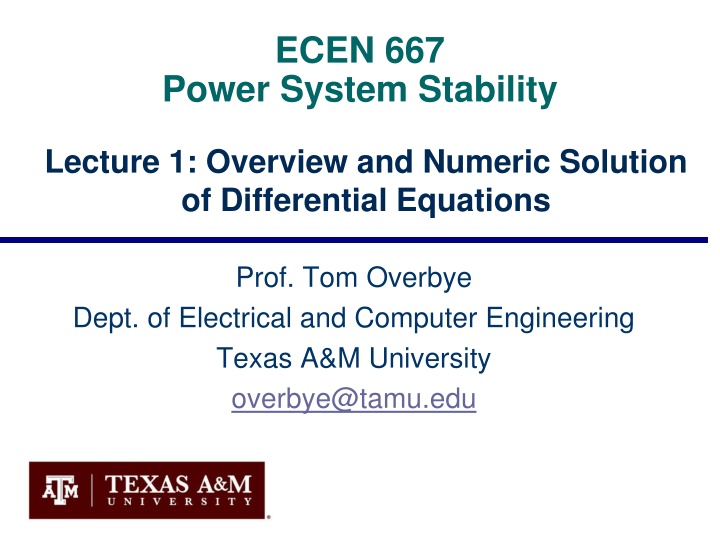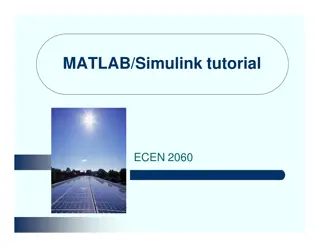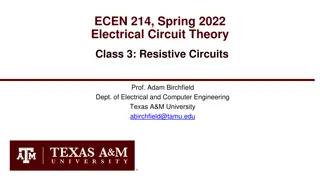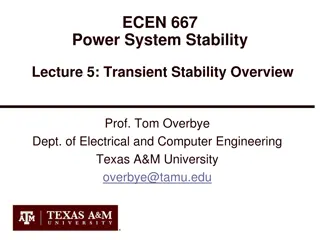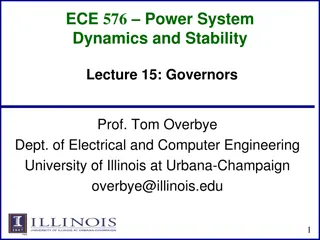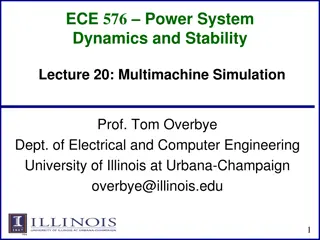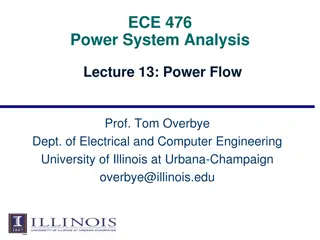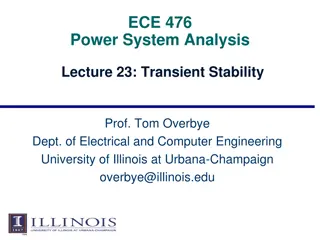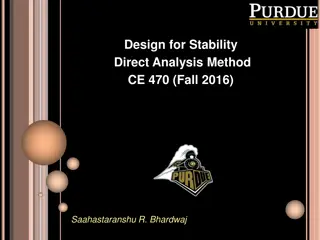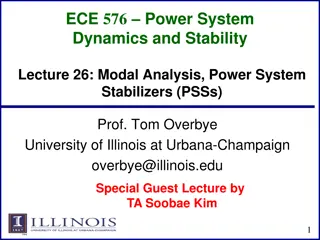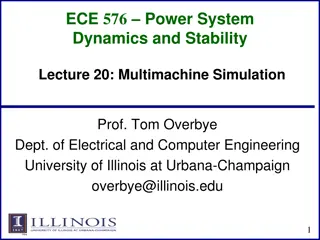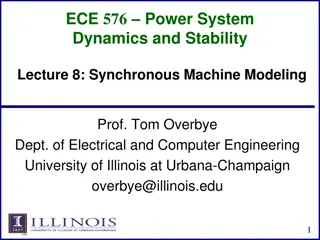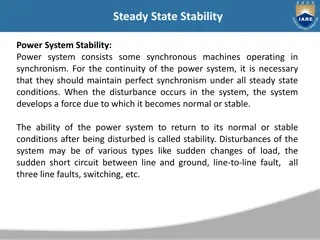ECEN 667 Power System Stability: Overview by Prof. Tom Overbye at Texas A&M University
In this comprehensive course on power system stability, Prof. Tom Overbye from Texas A&M University covers topics ranging from electromagnetic transients to energy function methods. The course provides insights into modeling synchronous machines, transient stability, signal analysis, and more. Prof. Overbye's expertise in power systems and his commercial power system analysis package, PowerWorld Simulator, enrich the learning experience for students interested in this field.
Download Presentation

Please find below an Image/Link to download the presentation.
The content on the website is provided AS IS for your information and personal use only. It may not be sold, licensed, or shared on other websites without obtaining consent from the author.If you encounter any issues during the download, it is possible that the publisher has removed the file from their server.
You are allowed to download the files provided on this website for personal or commercial use, subject to the condition that they are used lawfully. All files are the property of their respective owners.
The content on the website is provided AS IS for your information and personal use only. It may not be sold, licensed, or shared on other websites without obtaining consent from the author.
E N D
Presentation Transcript
ECEN 667 Power System Stability Lecture 1: Overview and Numeric Solution of Differential Equations Prof. Tom Overbye Dept. of Electrical and Computer Engineering Texas A&M University overbye@tamu.edu
Syllabus Book is available at www.stipes.com/catalog/electrical- engineering/power-system-dynamics- stability/19 1
ECEN 667 Public Website Publicly accessible website is overbye.engr.tamu.edu/course/ecen667fa2017/ Notes for the upcoming lecture will be posted ahead of time An earlier version of a quite similar course is available at courses.engr.illinois.edu/ece576/sp2016/
About Me Professional Received BSEE, MSEE, and Ph.D. all from University of Wisconsin at Madison (83, 88, 91) Worked for eight years as engineer for an electric utility (Madison Gas & Electric) Was at UIUC from 1991 to 2016, doing teaching and doing research in the area of electric power systems Joined TAMU in January 2017 Developed commercial power system analysis package, known now as PowerWorld Simulator. This package has been sold to about 600 different corporate entities worldwide DOE investigator for 8/14/2003 blackout 3
About Prof. Tom Overbye Nonprofessional Married to Jo Have three children Tim age 22 Hannah age 20 Amanda age 18 We ve homeschooled our kids all the way through, with Tim now in his last year at UIUC in ME and Hannah her third year in psychology, and Amanda just now starting at Belmont Attend Grace Bible Church in College Station 4
Course Topics 1. Overview 2. Electromagnetic transients 3. Synchronous machine modeling 4. Excitation and governor modeling 5. Single machines 6. Time-scales and reduced-order models 7. Interconnected multi-machine models 8. Transient stability 9. Linearization 10.Signal analysis 11.Power system stabilizer design 12.Energy function methods 5
Power System Time Frames Image source: P.W. Sauer, M.A. Pai, Power System Dynamics and Stability, 1997, Fig 1.2, modified 6
Modeling Cautions! "All models are wrong but some are useful," George Box, Empirical Model-Building and Response Surfaces, (1987, p. 424) Models are an approximation to reality, not reality, so they always have some degree of approximation Box went on to say that the practical question is how wrong to they have to be to not be useful A good part of engineering is deciding what is the appropriate level of modeling, and knowing under what conditions the model will fail Always keep in mind what problem you are trying to solve! 7
Dynamics Example 1 1996: Transient Stability Model Errors Lead to Blackouts 8
Dynamics Example: August 14 Blackout Image from August 14, 2003 Blackout Final Report, energy.gov, Figure 6.26 9
Dynamics Example 3 We ve come a long ways since 1996 towards improved simulations. Still, a finding from the 2011 Blackout is the simulations didn t match the actual system response and need to be improved. Source: Arizona-Southern California Outages on September 8, 2011 Report, FERC and NERC,April 2012 10
Models and Their Parameters Models and their parameters are often tightly coupled The parameters for a particular model might have been derived from actual results on the object of interest Changing the model (even correcting an "incorrect" simulation implementation) can result in unexpected results! Using a more detailed simulation approach without changing the model can also result in incorrect results More detailed models are not necessarily more accurate 11
Static versus Dynamic Analysis Statics versus dynamics appears in many fields An equilibrium point is a point at which the model is not changing Real systems are always changing, but over the time period of interest an unchanging system can be a useful approximation Static analysis looks at how the equilibrium points change to a change in the model Power system example is power flow Dynamic analysis looks at how the system responds over time when it is perturbed away from an equilibrium point Power system example is transient stability 12
Slow versus Fast Dynamics Key analysis question in setting up and solving models is to determine the time frame of interest Values that change slowing (relative to the time frame of interest) can be assumed as constant Power flow example is the load real and reactive values are assumed constant (sometimes voltage dependence is included) Values that change quickly (relative to the time frame of interest) can be assumed to be algebraic A generator's terminal voltage in power flow is an algebraic constraint, but not in transient stability In power flow and transient stability the network power balance equations are assumed algebraic 13
Positive Sequence versus Full Three-Phase Large-scale electrical systems are almost exclusively three-phase. Common analysis tools such as power flow and transient stability often assume balanced operation This allows modeling of just the positive sequence though full three-phase models are sometimes used particularly for distribution systems Course assumes knowledge of sequence analysis Other applications, such as electromagnetic transients (commonly known as electromagnetic transients programs [EMTP]) consider the full three phase models 14
Course Coverage Course is focused on the analysis of the dynamics and stability of high voltage power systems Some consideration of general solution methods, some consideration of power system component modeling in different time frames, and some consideration of using tools to solve example larger-scale power system problems Course seeks to strike a balance between the theoretical and the applied In theory there is no difference between theory and practice. In practice there is. -- Yogi Berra (maybe he said this, or perhaps anonymous) 15
PowerWorld Simulator Class will make extensive use of PowerWorld Simulator. If you do not have a copy of version 20, the free 42 bus student version is available for download at http://www.powerworld.com/gloveroverbyesarma Start getting familiar with this package, particularly the power flow basics. Transient stability aspects will be covered in class Free training material is available at http://www.powerworld.com/training/online-training 16
Power Flow Versus Dynamics The power flow is used to determine a quasi steady-state operating condition for a power system Goal is to solve a set of algebraic equations g(x) = 0 Models employed reflect the steady-state assumption, such as generator PV buses, constant power loads, LTC transformers Dynamic analysis is used to determine how the system changes with time, usually after some disturbance perturbs it away from a quasi-steady state equilibrium point 17
Example: Transient Stability Transient stability is used to determine whether following a disturbance (contingency) the power system returns to a steady-state operating point Goal is to solve a set of differential and algebraic equations, dx/dt = f(x,y), g(x,y) = 0 Starts in steady-state, and hopefully returns to steady- state. Models reflect the transient stability time frame (up to dozens of seconds), with some values assumed to be slow enough to hold constant (LTC tap changing), while others are still fast enough to treat as algebraic (synchronous machine stator dynamics, voltage source converter dynamics). 18
Interactive Simulation: PowerWorld Dynamics Studio (DS) 19
Power System Stability Terms Terms continue to evolve, but a good reference is [1]; image shows Figure 1 from this reference [1] IEEE/CIGRE Joint Task Force on Stability Terms and Definitions, Definitions and Classification of Power System Stability, IEEE Transactions Power Systems, May 2004, pp. 1387-1401 20
Physical Structure Power System Components P. Sauer and M. Pai, Power System Dynamics and Stability 21
Physical Structure Power System Components Mechanical System Electrical System Stabilizer Load Relay Line Relay Exciter Network control Supply control Pressure control Speed control Voltage Control Load control Fuel Source Furnace and Boiler Turbine Generator Machine Network Loads Load Char. V, I P, Q Fuel Steam Torque Governor 22
Differential Algebraic Equations Many problems, including many in the power area, can be formulated as a set of differential, algebraic equations (DAE) of the form ( , ) ( , ) = 0 g x y = x f x y A power example is transient stability, in which f represents (primarily) the generator dynamics, and g (primarily) the bus power balance equations We'll initially consider the simpler problem of just ( ) = x f x 23
Ordinary Differential Equations (ODEs) Assume we have a problem of the form ( ) with (t ) = x f x x = x 0 0 This is known as an initial value problem, since the initial value of x is given at some time t0 We need to determine x(t) for future time Initial value, x0, must be either be given or determined by solving for an equilibrium point, f(x) = 0 Higher-order systems can be put into this first order form Except for special cases, such as linear systems, an analytic solution is usually not possible numerical methods must be used 24
Equilibrium Points An equilibrium point x* satisfies ( *) = = x f x 0 An equilibrium point is stable if the response to a small disturbance remains small This is known as Lyapunov stability Formally, if for every > 0, there exists a = ( ) > 0 such that if x(0) x* < , then x(t) x* < for t 0 An equilibrium point has asymptotic stability if there exists a > 0 such that if x(0) x* < , then lim ( ) * t = x x 0 t 25
Power System Application A typical power system application is to assume the power flow solution represents an equilibrium point Back solve to determine the initial state variables, x(0) At some point a contingency occurs, perturbing the state away from the equilibrium point Time domain simulation is used to determine whether the system returns to the equilibrium point 26
Initial value Problem Examples Example 1: Exponential Decay A simple example with an analytic solution is x with x(0) x = = x 0 t = This has a solution x(t) Example 2: Mass-Spring System x e 0 = + kx gM Mx Dx or = x x 1 2 1 M ( ) = x k x gM Dx 2 1 2 27
Numerical Solution Methods Numerical solution methods do not generate exact solutions; they practically always introduce some error Methods assume time advances in discrete increments, called a stepsize (or time step), t Speed accuracy tradeoff: a smaller t usually gives a better solution, but it takes longer to compute Numeric roundoff error due to finite computer word size Key issue is the derivative of x, f(x) depends on x, the value we are trying to determine A solution exists as long as f(x) is continuously differentiable 28
Numerical Solution Methods There are a wide variety of different solution approaches, we will only touch on several One-step methods: require information about solution just at one point, x(t) Forward Euler Runge-Kutta Multi-step methods: make use of information at more than one point, x(t), x(t- t), x(t- t) Adams-Bashforth Predictor-Corrector Methods: implicit Backward Euler 29
Error Propagation At each time step the total round-off error is the sum of the local round-off at time and the propagated error from steps 1, 2 , , k 1 An algorithm with the desirable property that local round-off error decays with increasing number of steps is said to be numerically stable Otherwise, the algorithm is numerically unstable Numerically unstable algorithms can nevertheless give quite good performance if appropriate time steps are used This is particularly true when coupled with algebraic equations 30
Forward Eulers Method The simplest technique for numerically integrating such equations is known as the Euler's Method (sometimes the Forward Euler's Method) Key idea is to approximate d ( ( )) as dt t Then ( ) ( ) ( ( )) t t t t + + x x f x x x = = x f x t t In general, the smaller the t, the more accurate the solution, but it also takes more time steps 31
Eulers Method Algorithm Set t = t (usually 0) (t ) = Pick the time step t, which is problem specific 0 x x 0 0 end While t x t ) + Do x + = = + ( ( )) f x ( ( ) t t t t t t t t End While 32
Eulers Method Example 1 Consider the Exponential Decay Example x with x(0) x = = x 0 e t = This has a solution x(t) Since we know the solution we can compare the accuracy of Euler's method for different time steps x 0 33
Eulers Method Example 1, contd x(t) t=0.1 x(t) t=0.05 t xactual(t) 0 10 10 10 0.1 9.048 9 9.02 0.2 8.187 8.10 8.15 0.3 7.408 7.29 7.35 1.0 3.678 3.49 3.58 2.0 1.353 1.22 1.29 34
